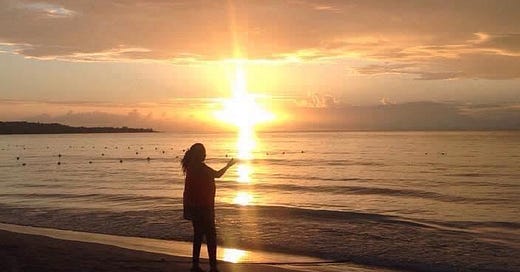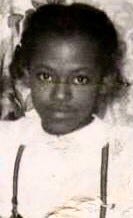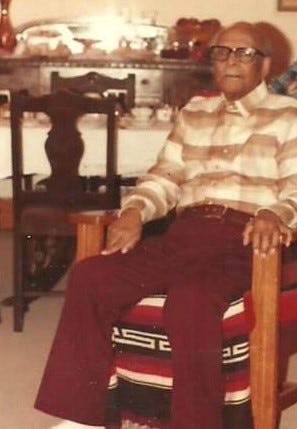February is Black History and it is a joyous month for me, however in some ways it a difficult one for me. It is understandably difficult because many times when we look at both our world and family history it contains incidents and events that involve tremendous pain and suffering weaved into the times of progress and joy
I had a whole other newsletter written and then the other night (around three in the morning) I was editing it and thought : “No! …I know I’m late, but this isn’t what I want for February, It’s not what is in my heart at this moment. I will put all that content in another newsletter. I am going to rewrite this issue and go in another direction.”
So, some of the next issues that I publish may include lots more Black History and stories.
I have photos of me and the display I would set up in the lobby when I performed my One Woman Show: ”Stay Black & Die”. A poster that was included in the display explained how growing up as a kid ( nicknamed “Penny” by my family) the grotesque little statues, dolls, ugly images of Aunt Jemima, and the little black Lawn Jockeys displayed on peoples front lawns used to make me feel so ashamed.
Here is the dialogue from my play and book, “Stay Black & Die”, that explains other shaming incidents young Penny endured:
[PENNY crosses from centre to stage right. (Feigning illness). She is having a conversation with her mother.]
“I don’t want to go to school today. I don’t feel good.”
“You get your black ass out of here for school girl, or I’ll GIVE you something to be sick about!”
Some days, I just wasn’t ready. I wasn’t ready for what I used to call, “The Hate Brigade” . Those were the kids who’d follow me to school every day if my brothers weren’t around and they’d hit me, they’d kick me, and sing their songs at me:
“Nigger, nigger, never die. Black face and shiny eyes, liver lips and flat nose, and on your head, dah wool grows.”
“Your head is nappy. Who’s your pappy? You sho’ an ugly chile!”
I could make it past The Lawn Jockeys. I hated them!
Those were the little metal statues everyone would stick out on the lawn every morning to water the grass. They were ugly, ugly, black, black, black boys. And they had big poppy eyes and flat noses spread all over their face, and they had big, BIG, ugly lips, all outlined and painted in white, and they had a hose stuck .....down there. [She Points to her groin] Down there! … And they’d gyrate around—and water the lawn.
They used to make me feel so ashamed. I’d put my head down and I’d go past them to school, dreading, knowing we had reading. I abhorred reading. It meant reading the same dumb stories: “Topsy”, “Little Black Sambo”, “Tar Baby”. I hated Topsy and every little braid and ribbon on her nappy little black head. And every time we read Topsy, thirty little white kids would turn around and stare at me. So I’d keep my nose buried in my book, and I’d sit there—[She breaks into a grin]—wishing I could melt into butter, like Little Black Sambo.
But today was different. We had a substitute teacher. She read us stories she brought with her in a coloured bag made of crocheted string from Ireland.
Irish stories, ....about little people who lived in a world where no one hates anyone, and everybody works together and plays together. Wow!
Afterward, she asked us questions and let ME answer most of ’em.
After school I Ran all the way home
I was so happy. My head was full of different stories and questions. I was so happy I went home forgetting to look out for ....”The Hate Brigade”, and I ran right into—oh-oh! Who is this? I had to run into the long passage between our house and the neighbour’s house. The houses in our North End neighbourhood were close together, really close, only about three feet apart, so on dull days it was almost dark in there. Scary.....
I tried to focus my eyes to make out which one of “The Hate Brigade” it was.
I looked around to see if my brothers were coming yet , but I was all alone.
I tried to fake it like I wasn’t scared. “Let me by! Let me by, Larry,” I said with false bravado. “Let me by. Come on. Please?”
Larry didn’t answer. He just kept standing there, towering over me. Then all of a sudden ... he just … stomped away.
Something was very wrong.
I was burning up.
I couldn’t see.
I couldn’t hear.
I felt like someone hit me with a brick! But I was still standing.
—And then I felt it … I felt it sliding down my face.
I just stood there. I don’t know how long.
I guess till I decided that the next person who spits in my face—I’m going to kill them!”
*******************************************************************************************************
Our Family home in the North End of Winnipeg at 627 cathedral. I used to sit on that Sunporch with my Dad where he usually sat in his favourite chair ( he stayed inside (mostly) after he went Blind) I used to read Shakespeare Sonnets to him. After I read one, I’d say: “You like that one Daddy?” and he’d smile and say. “ Hmmmmn”.
I used to read him Sonnet # 18 a lot, and tell him it was my favourite because it. reminded me of how I feel about him.
He’d just smile , and say: “Hmmmmm”, and then I’d read:
“ Shall I compare thee to a Summers Day
Thou art more lovely
and more temperate”….
My wonderful Dad. Walter Sumter.
***********************************************************************************************************
Black History:
I often introduce myself as a 7th Generation Canadian, and add that now my family now has 10 Generations born in Canada. That prevents the questions: Where are you from?… I mean where are you really, really, from?” My family knows we have more than ten generations born in Canada, because my Great Grandparents were Canadians, but I only count from the generations first recorded in our Family Bible (passed down from my Grandmother) who recorded the births of her 18 children.
Other than Historical Family stories from (mainly my Mom) I never learned stories of Black Canadian History. History taught in our schools was mainly World History, and American History, and a few Chapters of Canadian History. In Junior High and High School we had more Canadian History courses. None of those History classes or courses included Black Canadian History or discussed in any respectful manner the Slavery we had in Canada, only the Slavery in America.
When I first read about the book: “ White Ships/Black Cargo” about The Middle Passage, and saw the Art and writings by Tom Feelings. It rocked my whole world. The Art was Sixty-four stunningly brilliant illustrations that seared themselves into my Soul. Tom Feeling’s art described Slavery, and the Trans Atlantic journey of Slaves, in vivid Storytelling detail. His Art illustrations were more impactful than reading any books or accounting of Slavery that I had ever read. I am still (frequently) haunted by the images of the Atlantic Ocean sharks that followed the slave ships because of the food they could devour from the Slave bodies thrown overboard.
Below is the Link for The Black History Video: on You Tube: “The Middle Passage”—Tom Feelings
https://na01.safelinks.protection.outlook.com/?url=https%3A%2F%2Fyoutu.be%2F5qjtlQLQMj0%3Fsi%3DazEP1ZsxxIR3oSNT&data=05%7C02%7C%7C9adeb1af18f248d1011d08dd58371abd%7C84df9e7fe9f640afb435aaaaaaaaaaaa%7C1%7C0%7C638763715866182098%7CUnknown%7CTWFpbGZsb3d8eyJFbXB0eU1hcGkiOnRydWUsIlYiOiIwLjAuMDAwMCIsIlAiOiJXaW4zMiIsIkFOIjoiTWFpbCIsIldUIjoyfQ%3D%3D%7C0%7C%7C%7C&sdata=E8uLyA%2B%2B92JF7%2BOAg8X%2F04x%2BaPFOKpoTTYo58Rs%2B82c%3D&reserved=0
**********************************************************************************************************
The Middle Passage’s vivid Storytelling and stories of Slavery remained with me.
My friend and marvelous writer, Librarian, and Educator, Mary Duffy, used to invite writers, poets, and Artists to participate in Black History Month presentations at Britannia Library in Vancouver when she was a Librarian there. One of the times when she invited me, I did a presentation and showed some posters of Tom Feelings Art from his work: “The Middle Passage.” After my presentation in Vancouver, I had another Black History presentation in Ottawa. I was on the plane and I started thinking and wondering about what Slaves would have thought and how they would have reacted when they were brought to Atlantic Canada, if the ships arrived in October or November, and they experienced, (for the first time) seeing snow.
The Volcano Inside
When I was flying home to Vancouver from Ottawa a poem started to come to me or should I say through me I rummaged through my purse and I found a pen but no paper so I started writing the words on an air sickness bag, from the pocket of the seat in front of me I wrote all over the front the back the sides When I had written on every space on that bag I reached over and took the bag tucked behind the seat next to me and wrote and wrote and wrote. As I was writing, I was breathing rapidly And tears were flowing down my face There was a volcano erupting.
Someone was inside of me recalling the voyages, reliving the experiences.
This was a gift This poem
passed to me from a spirit who wanted to share her story so I could offer it to the world. I am honoured. And I am grateful that I was chosen.
New Lands
I left the lodge
as the drummers played
Kali Sherehe: the Sun Ritual
and Mamma d-a-n-c-e-d
and the elders sang: Yo!
Jua Kali Yo!
Yo Karibuni Yo
And the children waited to join in the chorus.
I picked up my baby Najma and I ran outside
into the sun with her.[CMR1]
“Sister Sun!”
“I l-o-v-e you, Sister Sun,” I sang as I ran.
Na Kupunda!
And the rays from her fire‑ball
warmed my back
and licked my thighs.
I laid Najma gently in the reeds
and they folded over her, snugly,
to give her shade.
And I threw my hands to the air.
tried to dance
tried to whirl
in the waters.
But they pulled me down
playfully
and I laughed
as I fell in
and let them caress me
in every fold
and every crack
between my fingers
and my toes.
And all the while
my sister warmed me
thru
and thru.
Suddenly
more darkness than closed lids
came upon me!
And the air
filled
with
a scent …
a scent of madness
and death
and
never‑to-be-the-sameness.
And through my ears came the sounds of hate
and greed
so foreign
yet instinctive.
I sounded first
in catch-of-breath
then
in … a cry
that came from ancestors
from predecessors’ graves
Oh! Oh! Hatari! Danger! Hatari!
My eyes opened
to see a group of human men
with strange
unhuman eyes …
the colour of the sea.
With lips
that curled
and sneered like Hyena
They yelled
some tribal gibber
somehow
I knew
involved
Death and Pain
to last four hundred years.
They covered me with woven ropes
threw them over me
like Boar!
Would I be eaten?
Stuck through with stick?
Roasted in a fire
and ripped apart
by their yellow-brown teeth
and lipless mouths?
That would have been kinder
Hush, baby! I prayed
Stay asleep in the shaded reeds.
Don’t crave this milk that drips from my breasts.
Sleep! Don’t cry!
Usi Lia Mwangu Angu
Mama Ana Kupenda Sana
Mama loves you lots.
Hard carved sticks
cracked my head
like coconut.
Blood
ran into my eyes
and stinged
and burned
and blurred the shapes of the monsters all around.
Then
blackness
took me …
Slaps
and kicks
and salty water
thrown across my torso
woke me
lying on a … strange giant wooden boat
that rocked a crazy motion
and threw my fluids up
from my stomach.
The woven cage
was off me now
replaced by a hard choking band
round my neck.
The same bonds claimed my ankles
close together
and … connected me
to another Black
not from my family!
Not from my village!
Those sea-eyed creatures
threw
and dragged us
down.
Down
into a dark
dark
hole.
Piled like wood we lay
bound
screaming
and crying
and moaning
and
dying.
Tears.
Blood.
Sweat.
And shit
from those piled above
dripped down
over us
and bathed us
in the shame
and regret
that would be
our legacy.
It may have been
a year
a day
a month
or two.
I woke
I dreamed
I cried
I screamed
Usi Lia Mwangu Angu
Don’t cry, my love.
And all the while … this
Rocking!
Cramping!
Heaving!
Churning!
Stomach.
I longed for
stillness
And … air!
I long to wake
from this dream
and hold my baby
Mama ana ku penda sana
Mama ana kupenda sana
Those humans came for us!
They dragged
and pulled us … up
Frightened.
Defeated.
Defiant.
Resigned.
Up … up
into a wider
w-i-d-e
open
space on this giant boat.
A different air
pushed through my nose
coldness touched my face
in strange puffs of wind.
My whole body shook
and my teeth beat together
and sounded like Woodpecker
My eyes saw earth
beyond the water
but it could not be earth!
It was …White.
Through the cold
I felt a strange
… heat …
that came from a bright round light
in the sky.
It was almost familiar
Almost …
Somehow.
But I knew
this Ball-of-Fire in the sky
was no relative of mine!
And I was more afraid
than I had been
since those creatures
darkened my light.
I knew
I would never be taken home again.
And tears came down
they ran down cold
freezing my cheeks.
And the tears that ran
from my eyes ran because
I knew …
I might live a while.
© 2009 Addena Sumter-Freitag
*************************************************************************************************************
February is observed and celebrated as “Black History Month” in many parts of the world. It is a month to look at, and introduce the world to the stories and Black Histories from all across the Diaspora. Black History Month can, like history does, remind us of turbulent, tragic, and traumatic times, and that is why we should remind ourselves to include telling of all the Joys and triumphs we have in our histories.
We should be reminded to be Joyful and proud of all the exciting and innovative Music, Dance, Architecture, Art, and Literature that we have introduced into the world and we can proudly celebrate those contributions with our Chosen Families, Friends, chosen Community with Full Joy!
Speaking of joy… Do you know what is the term: Black Joy refers to?
Black Joy: is the celebration of Black culture and resilience in the face of racism and oppression. It is celebration to find healing and nourishment, and to create a sense of community. Being filled with, and spreading Black Joy is also an opportunity to build new communities with allies and other diverse groups working for social justice and equity.
Black Joy can be expressed through art, music, and family traditions, but it can also be expressed through activism , and by choosing outlets that brings you joy and pleasure to helping to ease the pain of present and past trauma.
Finding Black Joy puts emphasis on “Community”. It involves us forming and nurturing our personal community and together resisting systems that devaluate Black people. It is a time to remind us to actively find outlets for self expression, and find Joy, in our, and other’s creativity, innovation, and brilliance .
For example, as Artists we can use our art to represent other under-represented people and their issues and help bring social and justice issues to the forefront.
Why Black Joy is important : Joy is a vital part of mental well-being.
Joy produces a counter narrative to the focus on trauma and systemic oppression.
Joy highlights the creativity, successes, and enduring spirit within your chosen community.
It is a way to rest, the body, mind, and Spirit in response to racialized experiences.
Joy is is everyone’s path to Healing.
One Love,










Wow, Adenna. It's hard to find the words to describe how much your words have moved me, and the poem is both beautiful and gut-wrenching. You do a wonderful job of expressing your truth. Your strong spirit shines through.
Oh, Addena (Penny), I am so sorry this horrible treatment happened to you. I can relate to a certain degree. I didn't look like my classmates & was chased, bullied and called Squaw. Ignorance causes pain and too often the most vulnerable are the easy victims. I have more to share on this subject but will save it for a time when we are together in person. I hope we can make that happen - in Jamaica - at least once before we are too old to make the trip! Love you!!!!